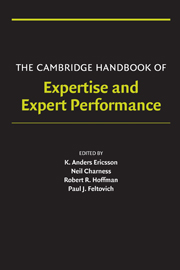Book contents
- Frontmatter
- Contents
- Acknowledgments
- Contributors
- PART I INTRODUCTION AND PERSPECTIVE
- PART II OVERVIEW OF APPROACHES TO THE STUDY OF EXPERTISE – BRIEF HISTORICAL ACCOUNTS OF THEORIES AND METHODS
- PART III METHODS FOR STUDYING THE STRUCTURE OF EXPERTISE
- PART IV METHODS FOR STUDYING THE ACQUISITION AND MAINTENANCE OF EXPERTISE
- PART V DOMAINS OF EXPERTISE
- PART VI GENERALIZABLE MECHANISMS MEDIATING EXPERTISE AND GENERAL ISSUES
- 34 A Merging Theory of Expertise and Intelligence
- 35 Tacit Knowledge, Practical Intelligence, and Expertise
- 36 Expertise and Situation Awareness
- 37 Brain Changes in the Development of Expertise: Neuroanatomical and Neurophysiological Evidence about Skill-Based Adaptations
- 38 The Influence of Experience and Deliberate Practice on the Development of Superior Expert Performance
- 39 Development and Adaptation of Expertise: The Role of Self-Regulatory Processes and Beliefs
- 40 Aging and Expertise
- 41 Social and Sociological Factors in the Development of Expertise
- 42 Modes of Expertise in Creative Thinking: Evidence from Case Studies
- Author Index
- Subject Index
- References
37 - Brain Changes in the Development of Expertise: Neuroanatomical and Neurophysiological Evidence about Skill-Based Adaptations
from PART VI - GENERALIZABLE MECHANISMS MEDIATING EXPERTISE AND GENERAL ISSUES
- Frontmatter
- Contents
- Acknowledgments
- Contributors
- PART I INTRODUCTION AND PERSPECTIVE
- PART II OVERVIEW OF APPROACHES TO THE STUDY OF EXPERTISE – BRIEF HISTORICAL ACCOUNTS OF THEORIES AND METHODS
- PART III METHODS FOR STUDYING THE STRUCTURE OF EXPERTISE
- PART IV METHODS FOR STUDYING THE ACQUISITION AND MAINTENANCE OF EXPERTISE
- PART V DOMAINS OF EXPERTISE
- PART VI GENERALIZABLE MECHANISMS MEDIATING EXPERTISE AND GENERAL ISSUES
- 34 A Merging Theory of Expertise and Intelligence
- 35 Tacit Knowledge, Practical Intelligence, and Expertise
- 36 Expertise and Situation Awareness
- 37 Brain Changes in the Development of Expertise: Neuroanatomical and Neurophysiological Evidence about Skill-Based Adaptations
- 38 The Influence of Experience and Deliberate Practice on the Development of Superior Expert Performance
- 39 Development and Adaptation of Expertise: The Role of Self-Regulatory Processes and Beliefs
- 40 Aging and Expertise
- 41 Social and Sociological Factors in the Development of Expertise
- 42 Modes of Expertise in Creative Thinking: Evidence from Case Studies
- Author Index
- Subject Index
- References
Summary
Introduction
As humans acquire skills there are dramatic changes in brain activity that complement the profound changes in processing speed and effort seen in behavioral data. These changes involve learning, developing new representations, strategy shifts, and use of wider cues and approaches. Experts differ from novices in terms of their knowledge, effort, recognition, analysis, strategy, memory use, and monitoring (e.g., see Chi, Chapter 2; Feltovich, Prietula, & Ericsson, Chapter 4). In the last decade, there have be major advances in our ability to noninvasively track human brain activity. There are now over a hundred experiments tracking learning or expert performance. Patterns are beginning to emerge that show that learning and skilled performance produce changes in brain activation – and different types of changes – depending on the brain structure and the nature of the skill being learned.
In this chapter, we will review the changes that occur in the brain as skill is acquired. We will detail the anatomy and processes involved. We will provide a brief summary of the methods employed. We will review the nature of learning of skills, resource utilization, and performance of experts. The reader who wishes to learn more details regarding these methods might examine a current introductory chapter (Schneider & Chein, 2003) or current textbooks of cognitive neuroscience (Gazzaniga, Ivry, & Mangun, 2002), brain imaging (Jezzard, Mathews, & Smith, 2001), and cognitive neuroscience modeling (O'Reilly & Munakata, 2000).
- Type
- Chapter
- Information
- The Cambridge Handbook of Expertise and Expert Performance , pp. 653 - 682Publisher: Cambridge University PressPrint publication year: 2006
References
- 44
- Cited by

